#chioggia beetroot
Photo

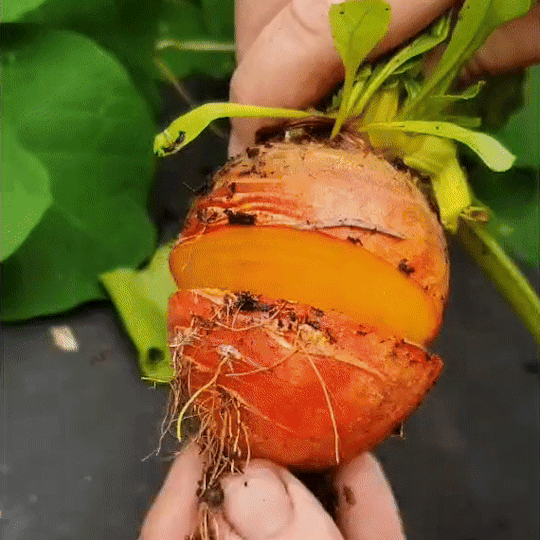
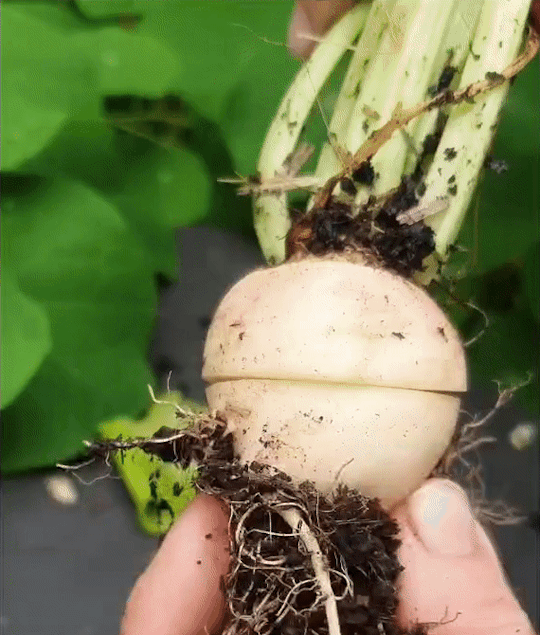
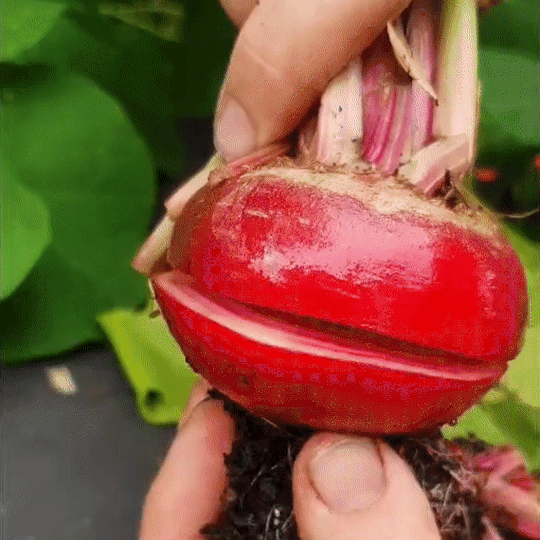
various types of beetroot | source
#talos gifs#stim gifs#stim#food#plants#gardening#irl hands#beet#beetroot#orange#white#red#pink#green#roots#dirt#cottagecore#?#vegetables#chioggia beetroot
1K notes
·
View notes
Note
The beetroot really makes you very attractive. How'd it taste?
(In reference to my almost-prize-winning Barbabietola di Chioggia beetroot of extreme romantic eligibility, which I’ll share here again)

Here’s some stolen descriptions of the general characteristics of the Chioggia heirloom beetroot. Note how they generally stress that it tastes “mild”, I.e. not earthy, I.e. not much like beetroot.



Sweet and tender even at eight-point-buck size, and with a selling point of “not tasting VERY much like the thing most people hate about beetroot,” the Chioggia is pretty reliable.
I cut it in half, roasted it in its skin with olive oil and salt, then peeled the skin off and ate it. I had to eat it mostly by myself, since my family will tell you that it was awful, but I found it DELICIOUS. They caramelise when roasted and are sweeter than sweet potato, with a yielding firmness that you can cut with a spoon but still offers some resistance. You can imagine a balsamic glaze and goat’s cheese, etc.

182 notes
·
View notes
Photo
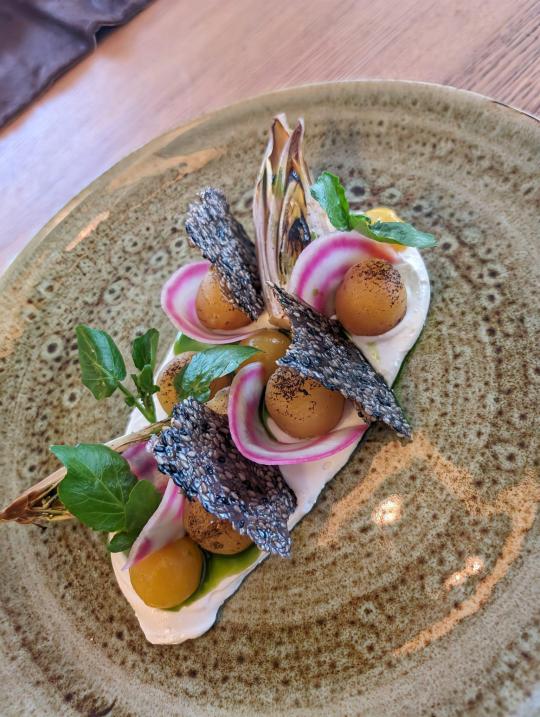
🍥 Vegetarian starter: Roasted yellow beetroot|Passionfruit| Tahini-goats cream cheese| Mint-oil| Grilled endives| Chioggia beets| Sesame crisp
🍔YouTube || 🍟Reddit
#BakingDay#MexicanFoodLove#lentils#TopAsianFood#MorningBrunch#BrunchTime#DessertLove#DessertStory#FoodTrucks#FoodTruckFestival#NewMexicanFood#DessertIdeas#BakingFromScratch#Brunch#FoodMexican#yogurt#BrunchIdeas#black pepper#AsianFoodLove#BakingClass#MexicanFoodPics#DessertsOfInstagram#FoodTruckStop#HealthyFoodRecipe#CleanEating#MexicanFoodies#cilantro#onion#DessertPic#AsianFood
2 notes
·
View notes
Text

Since it's almost officially winter, I have to act up on my fall/winter bucket list!
For my "warming breakfast recipe" I wanted something packed with veggies but not a smoothie (too cold) nor oatmeal (not ready to try the savory oatmeal again). Stumbled across a recipe for a vegan quiche and realized I had all the ingredients at hand, except smoked tofu instead of regular and yellow beet instead of normal.
It came out sooo delicious!!! The smoked tofu and nooch give it this ham and cheese flavor, the pumpkin crust is luscious and the beets (Chioggia) are super sweet. Had a slice for dinner but can't wait to have this for breakfast tomorrow!
#vegan#quiche#breakfast#meal prep#eat your veggies#pumpkin#tofu#spinach#vegan protein#recipe#bucket list 23/24
1 note
·
View note
Link
0 notes
Link
0 notes
Text
https://www.riverford.co.uk/organic-fruit-veg-and-salad/vegetables/chioggia-beetroot
0 notes
Text
What Do Pickled Beets Taste Like?
Beets might look scary and not in any way shape or form engaging. Thus, many individuals who are new to them avoid getting them and never attempt them through and through without thinking about their taste.
This carries us to the inquiry: what do beets possess a flavor like? All things considered, it relies upon who you are inquiring. Beet darlings say they have a sweet, rich, hearty flavor, yet beet critics say they taste like soil. Which articulation is valid?
cutting board with cut red beets
What Are Beets?
Beets are root vegetables that come as round bulbs with leaves. They have a shape like radishes and turnips. The principal base of beets develops upward under the ground, like carrots.
In North America, they are called beets. In English, they are called beetroots.
Their variety changes, yet they are typically dark red to dazzling purple. Nonetheless, they can likewise be yellow and white. There are likewise striped beets which are most normally called Chioggia beets.
A beet prepared for collect is about the size of a tennis ball, however some become bigger relying upon their assortment and their development. Crude beets are crunchy, so they can add freshness to your dish. Nonetheless, they become smooth and delicate subsequent to cooking.
Canned beets additionally exist, and they taste better than new beets. You can find them in most supermarkets. Beets can be eaten without being cooked; the vast majority even say that crude beets taste better compared to cooked ones.
What Parts Are Edible?
All pieces of the beet are palatable - bulbs, leaves, roots, and stems. The entire beet might in fact be eaten crude.
Roots
Individuals know the foundations of a beet as the actual beet. Beetroots can be eaten crude and added to servings of mixed greens. You can broil, steam, heat, pickle, squeeze, or mix them in your smoothies.
Leave no less than two creeps of the stem when you separate the beets from the greens so they won't drain their red tone. It is additionally best to decrease cooking time when the beets are more modest than two inches.
Skin
Some find it trying to strip beets, however fortunately there is compelling reason need to strip them at all on the grounds that their skin is palatable. Simply guarantee that you wash off the sinewy strings and soil from the beet skin prior to eating them.
Nonetheless, assuming you should strip beets, it is ideal to cook them first in light of the fact that the skin will strip off effectively in the wake of cooking.
Leaves
Likewise called beet greens, the leaves of beets are most frequently discarded in light of the fact that it isn't commonly realized that they are eatable. Beets have little, delicate leaves ideal for plates of mixed greens. They can likewise be sautéed, steamed, bubbled, or added to smoothies. Beet passes on are additionally fine options to your pasta, egg scrambles, or omelet.
Stems
New beets have little stems that are not excessively sinewy. These stems can be eaten crude or cooked, however they are best when sautéed in olive oil, garlic, and lemon juice. Steamed beet stems are likewise a famous fixing in soups, while the crude stems are extraordinary when added to smoothies or making pickle beet stems.
What Do Salted Beets Have an aftertaste like?
What Do Pickled Beets Taste Like?Cured beets generally have a hearty taste, a sensitive harmony among tartness and pleasantness. Be that as it may, this taste can change contingent upon how you pickle them in light of the fact that the kind of cured beets additionally relies upon different elements of your recipe.
Pickling includes blending food in an acidic arrangement containing salt, vinegar, and sugar. This cycle helps protect food and produces a serious flavor. Some main add sugar and salt less the vinegar, while others add garlic and pepper seeds or fiery peppers.
The sweet, zesty, sharp, and hot blend of salted beets will at first confound your taste buds, yet it is a fantastic enhancement for your tacos. They are additionally great substitutes for cooked beets.
What Does Beetroot Pose a flavor like?
At the point when you wash and appropriately get ready new beets, they will have a sweet, hearty, and marginally flower flavor. The pleasantness turns out to be more unmistakable relying upon the beet assortment and readiness.
Geosmin is a natural compound created in the dirt by organisms that is liable for the gritty taste of beets. Different vegetables like mushrooms, spinach, and lettuce additionally have elevated degrees of geosmin. That being said, assuming you love mushrooms and spinach, you will in all likelihood cherish beets.
What Do Simmered Beets Have an aftertaste like?
Broiling draws out the concentrated kind of beets, adding a sweet taste to the beets while eliminating their hearty, soil like taste. Along these lines, cooked beets generally taste sweet, with just barely a touch of harshness.
It is not difficult to make broiled beets, which are a superb fixing in numerous recipes. This cycle requires about an hour for entire huge beets, however cutting them into wedges or quarters speeds up the broiling time.
Red Beets Versus Brilliant Beets
The distinction among red and brilliant beets is negligible, so they can fill in for each other on the off chance that tone isn't an issue. Nonetheless, there are a few distinctions significant.
Red beets have adjusted to praise shape and a little taproot stretching out from its end. They turn delicate and delicate in the wake of cooking and have a sweet, hearty taste.
Then again, brilliant beets are different beets that need red shades and have a semi-harsh skin. They are round with an unpredictable, level shape, and their foundations are associated with their long, fresh green stems.
Red beets have a more unpleasant surface than gold beets, so it is gentler to strip and cut brilliant beets than red beets.
Brilliant beets taste marginally milder and better than red beets however have a less natural taste than their red partners. Consequently, on the off chance that you could do without red beets that much, there is a generally excellent possibility that you will cherish brilliant beets.
Ultimately, red beets drain while brilliant beets don't.
0 notes
Text
Beetroot farming

Today, we're focusing on the best beetroot farming techniques and practices. From choosing the best varieties, and controlling pests and diseases to harvesting.
Beetroot is a type of vegetable mainly grown due to its edible root. The plant produces red oval roots and leaves that usually grow up to 40 centimeters in length.
Beetroot farming is easily manageable and effortless. The main counties producing beetroot in huge tonnes are Kiambu, Nakuru, and Tharaka Nithi.
Beetroot's main health benefits
Excellent source of dietary fiber that helps in digestion
Beetroot helps to prevent cancer due to the presence of anti-cancer properties like phytonutrients
Rich in vitamin B that reduces birth defection risks.
Excellent source of vitamin C which helps the pancreas, kidneys, bones, and liver in the body.
Best beetroot varieties
- Burpee’s Golden - this is a good flavoured variety that produces round and yellow roots and its leaves can be consumed like spinach
- Cylindra - this is a dark crimson cylindrical variety that is highly resistant to bolt.
- Chioggia Pink - these are red and round root varieties. They are usually surrounded by beautiful red and white rings inside and are so sweet and tender.
- Detroit 6 Rubidus - has round and firm roots and also it's highly resistant to bolt disease.
- Bolt hardy - this variety possesses bolt resistance characteristics and also produces smooth round roots.
Best climatic requirements for Beetroot farming
Beetroot requires cool weather conditions and can be grown throughout the year as long as there is plenty of water for irrigation. Nonetheless, it can tolerate medium heat and extreme cold temperatures.
The optimum temperature required must be between 15 - 25 °c. Extreme temperatures results in lower production.
Well-drained fertile soils with a ph of 6 - 7 is also required.
Preparation of land

Before planting ensure the land is clean and free from weeds and plough the land and also keep the soil fine-tuned for good aeration.
It is important to apply drenching pesticides to kill and destroy their eggs which might be lying in the field.
Beetroot propagation
Propagation is mainly practiced using seeds. Beet seeds can be sowed 2cm deep, 7cm apart from each plant, and about 40cm between rows. After sowing, you can expect the seeds to start germinating between 12 - 14 days. It takes about two months to reach maturity.
Thinning
After two weeks after germination, seedlings need to be thinned to attain about 4 to 5 inches of spacing. This is done to minimize overcrowding. Usually, the weaker seedlings are removed to allow the stronger ones to grow without disturbance.
Important to note that, when the plants are too close to each other they occasionally produce poor-quality roots that are small in size.
Irrigation
After planting the seeds irrigation should follow immediately. During the dry season, plenty of water needs to be availed for the crops. For a faster germination process, a lot of water is required.
When there is a lack of enough water it usually results to woody low quality roots.
Weeding and mulching
To avoid nutrient competition, weeds should be always removed when they start to appear. Mulching should also be practiced for good maintained soil structure and moisture.
Regular crop rotation
The best way to fight crop pests and diseases is through crop rotation practice. This is done through planting non-family or non-related crops after harvesting previous crops.
Fertilizing
Beetroot requires three main nutrients to be supplied through the soil and that is; nitrogen, phosphorus, and potassium. In a hectare of land, you'll need to apply about 70kg of nitrogen, 120kg of phosphorus, and 100kg of potassium to your farm. In addition, compost manure may also be added so as to aid good aeration.
For soils that are boron deficient consider boric acid application. This is because boron deficiency causes beetroot to be weak.
How to water your plants
Watering starts immediately after sowing all beetroot seeds in the soil. Once the roots are established, they start acquiring moisture from the soil.
You should always be careful to avoid over-watering since this practice leads to bolting(production of many leaves with no roots). Whereas under-watering produces woody roots.
Watering should always be done 5 times a week in the dry season and 2 times per week during the cold season.
Pests and diseases
Beetroot is a unique crop that doesn't have so many enemies, the only common disease is leafspot. The signs are black spots on the leaves. Leafspot is prevalent in hot weather conditions. The best method to control is through crop rotation.
Harvesting

Beetroot harvesting is usually done in about 9 weeks after planting. During this time the bulbs are 2.5 to 3 cm in diameter and when they are soft and tender. Bigger beetroots than this size are occasionally rescinded by the market.
Yield potential
When best agricultural practices are observed beetroot can produce between 250 - 300 tonnes per hectare. You must also be alive of the fact that seed variety, soils, and other elements of production are dependent to achieve high yields.
Important tips to note in beetroot farming
- Seeds must be sowed slightly before frost season
- Beet plants require soils rich in organic matter
- Soak seeds in 24hrs to break seed dormancy
- Bone meal addition to the soil helps in the production of nitrogen and phosphorus
- When the leaves start turning Yellow it shows there is a nutrient deficiency.
- Beetroot harvesting is done 70 days after planting.
Market
Beetroot farming is a profitable business venture when compared to other vegetables. In Kenya for instance a kilo of beetroot costs around kes80 - kes120 in major supermarkets and other multiple markets in the country.
Read the full article
0 notes
Photo

tofu and avocado salad
#tofu and avocado salad#salad#tofu#avocado#soy sauce#tamari#watermelon#baby spinach#spinach#micro greens#parsley#watercress#cucumber#chioggia beetroot#beetroot#chioggia#lime#sesame seeds#spring onion#onion#food#vegetarian#vegan#this
278 notes
·
View notes
Photo

I add leek to my soup regularly. I am very fond of all kinds of allium, but leek is an unusual taste and maybe not for everybody. One of my strangest cooking memories is making a really heavy beet soup one afternoon, while watching on television a broadcast of Laurence Olivier’s film adaptation of Henry V, in which leek is notably featured. The soup was very heavy on the beet. Not only did it turn everything red, it made even the leek taste like beet. Since that time, I have relied heavily on chioggia beets, which don’t bleed as much and have a less imposing taste. As Shakespeare’s Fluellen would agree, I want to be able to taste my leek!
#leek#soup#organic food#allium#cooking#television#laurence olivier#shakespeare#henry v#beetroot#chioggia
2 notes
·
View notes
Text
barbabietola di Chioggia beetroot roasts up very tender even at prize size
95 notes
·
View notes
Photo


Beets
102 notes
·
View notes
Photo
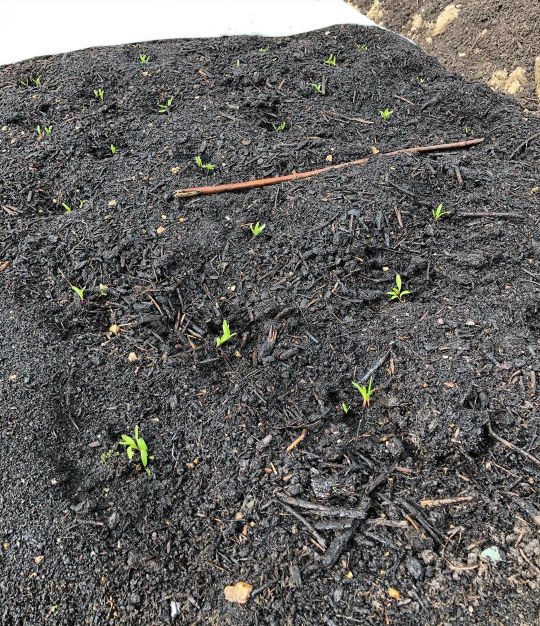
baby beetroot joining the big league and graduating from under fleece in the front garden to under fleece in the field #allotment #beetroot #chioggia #golden #growyourown #seeyoulaterlads (at Ardleigh) https://www.instagram.com/p/B-Y3Pwbp0u5ZrEjiE_vyL7iRG4tDZPAR0Q5vUE0/?igshid=mhoyu1o2xfaa
0 notes
Text
Apocalyptic or Biblical
Take your pick as how to describe the current weather. One decent half day and night of rain since 20 March is not good for anybody except the odd cacti or scorpion, and now yesterday and today, yet again a high strength wind, this time from the south west giving a constant 45 mph battering. The garden looks like a war zone, leaves and twigs everywhere and many a just about to flower perennial looking weary and battle scarred. Clear up tomorrow yet again and I like every gardener in the country am beginning to be extremely FED UP.
However I have planted out all the Cosmos I need and the Nicotianas, so have just got some snapdragons to do and then all the little nooks and crannies will be filled. It is useful to jam these annuals right up against the tatty allium leaves as they will soon be disappearing only to leave unwelcome gaps which until now were heavily disguised. I did also manage despite the wind, to transplant the beetroot Chioggia seedlings so have avoided the ant irritation, and equally the coriander with lemon flavour. I have resorted to sowing some spinach in the same way - 50 in modules as otherwise we shall get nowhere.
I mentioned a few weeks ago using soft soap to eradicate aphids, whitefly, lily beetle etc. I can now reliably inform you that Black Marseille soap is back in stock with French Soaps who are based in Harrogate. It is an excellent product and also very useful for basic household cleaning. Through them incidentally I buy traditional soap flakes, made in Yorkshire, which if you follow the instructions, mix to a thick goo and store in a tupperware container, to then put scoops into the washing machine, are a brilliant alternative to traditional soap powder. They resemble the old Lux flakes - but being Yorkshire a little goes a long way and they come in eco friendly paper bags. Have a look!
The veg patch actually is now doing well - all the salads are either ready or about to be, new cut and come again leaves were sown today. Shallots and red onions are good but I have to keep up regular watering. Asparagus is fantastic and all bar one of the new plants I filled in some gaps with, have come through. Artichokes are starting. The beans planted out last weekend have survived their first week and the climbing shoots have struck out. Leeks and Purple sprouting broccoli are marking time in the coldframes and the broad beans are forming up well. I have sown some cucumber and they have all come through in about three days flat - I am thinking of planting them out in the cold frames as they become empty over the next couple of weeks. All the courgettes have gone out as well so now we are beginning to look a bit more self sufficient! Some lovely gooseberries and red currants are showing and if as they seem to think we might get some rain early in June, it will be just in time to swell them up.
Dogs are in good heart - the bi-annual excitement of Mavis coming in season is once again upon us, but we have had to stand down on the lovely Yorkshire boy as under the current circumstances it seemed a long haul that might not be popular. (Though having said that and having seen today’s news I really dont think it matters what one does now - double standards abound). Anyhow being more considerate that some we have elected to stay within our patch and are off to visit Bellspaddle Roscoe, a fine “fox red” gentleman who lives near Watton. Fox red doesnt really exist - labradors are either yellow or black with variations on the yellow from dark to pale - so he is dark yellow. He is a Field Trial Winner and from an excellent stable so please please Mavis, this time can you co-operate as we have no less than 8 puppies wanted. The social event of the year will take place around 1st and 2nd June. Scout and Inca are therefore preparing themselves for a lot of upheaval as it is rather a stressful couple of weeks for them!
Bees are in good shape - yet another swarm which has been successfully hived. The unstable weather does however make them very grumpy and we are now most definitely in the June gap so there is very little food for them as well. Consequently I got stung on the cheek whilst minding my own business at the top of the garden, but they are volatile like the firmament at the moment whizzing about on this warm wind desperately seeking food. The rape and fodder beans have finished flowering, the gardens at the moment dont really provide their sort of food and the hawthorn flowers and blossoms are also finished. Living in such an agricultural area, they now have to wait for the blackberry to flower on the common, and until then may even have to be fed with syrup as they are at maximum production of youngsters with each colony building up to as many as 60,000 bees.
We have baby swallows who hatched about four or five days ago, and 3 pairs of swifts in residence in the roof. The barn own has been back hunting up and down both just outside and over the garden which is lovely, and a large number of roe deer are still about - I think I mistakenly said the roe rut was on, but this is not the case, the barking is in fact the parents telling last years babies to now make their way in the world before they have the next generation. But they are lovely to see especially now they have moved off from the garden!
Next time I write we shall be in full rose season - the Maigold is coming to an end and I am desperately trying to paint her but it is very difficult! Buff Beauty is just starting outside the sitting room window, and the beautiful species rose Rosa nutkana is full of flower.
Keep your fingers crossed for some rain - the grass and verges look like August! And keep watering containers and sweet peas in particular and feed them.
HORTA
1 note
·
View note
Photo
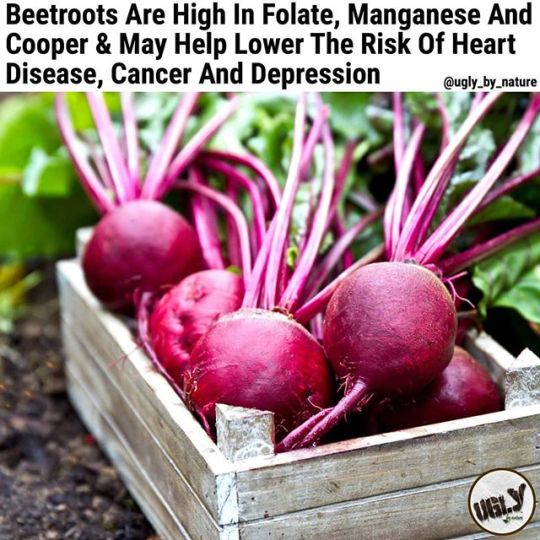
Best known for their deep red (almost purple) color, #beets actually come in several shades. Most stores stock red beets, so you may have to go to the farmer’s market or specialty foods store to find these less common types. 1. Chioggia: Also called Candy Cane beets, Chioggia beets are red on the outside and red and white striped on the inside. These are heirloom beets with a distinct sweetness. 2. Golden: Golden beets are yellow-orange and have a more neutral taste. They also have the advantage of not bleeding when cooked. 3. White: They may have a very mild taste and look like turnips from the outside, but white beets are still in the family. 4. Formanova: These beets stand out from the others at almost eight inches long! They’re cylindrical in shape, resemblant of a sweet potato in size. 5. Lutz Green Leaf: This variety can be up to four times the size of other round beets — about six inches in diameter. Also called “winter keeper” beets, these are known for their long shelf life. Note that they become less sweet the larger they grow — a common tradeoff in root vegetables. #Beetroots are especially high in folate, manganese, and copper. 1. Folate is essential for DNA synthesis and preventing neural tube defects in babies. It’s also been shown to reduce risk for heart disease, #cancer, and #depression. 2. Manganese is needed for enzymatic processes in your body, as well as for metabolism, wound healing, and healthy bones. 3. Copper keeps your immune system healthy, helps create red blood cells, and supports energy production. Source: https://ift.tt/33axv7O . . . https://ift.tt/2VkOL7H
4 notes
·
View notes